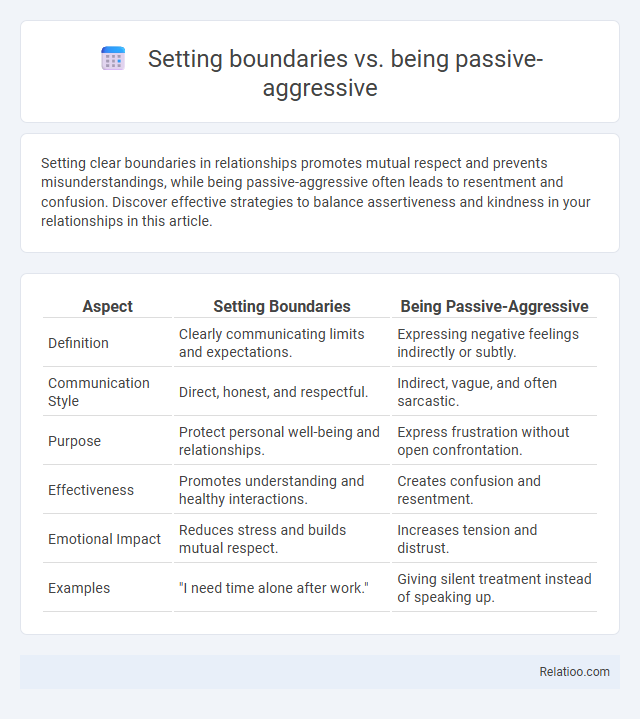Setting clear boundaries in relationships promotes mutual respect and prevents misunderstandings, while being passive-aggressive often leads to resentment and confusion. Discover effective strategies to balance assertiveness and kindness in your relationships in this article.
Table of Comparison
| Aspect | Setting Boundaries | Being Passive-Aggressive |
|---|---|---|
| Definition | Clearly communicating limits and expectations. | Expressing negative feelings indirectly or subtly. |
| Communication Style | Direct, honest, and respectful. | Indirect, vague, and often sarcastic. |
| Purpose | Protect personal well-being and relationships. | Express frustration without open confrontation. |
| Effectiveness | Promotes understanding and healthy interactions. | Creates confusion and resentment. |
| Emotional Impact | Reduces stress and builds mutual respect. | Increases tension and distrust. |
| Examples | "I need time alone after work." | Giving silent treatment instead of speaking up. |
Understanding Boundaries vs Passive-Aggressiveness
Setting boundaries involves clearly communicating your needs and limits to protect your well-being, fostering healthier relationships and mutual respect. Passive-aggressiveness manifests through indirect expressions of anger or resentment, often creating confusion and tension without addressing the underlying issues. Understanding the difference helps you assert your needs constructively rather than resorting to behaviors that undermine open communication and trust.
Signs You’re Setting Healthy Boundaries
Setting healthy boundaries involves clearly communicating your needs and limits without fear or guilt, ensuring mutual respect in relationships. Signs of this include assertive yet calm language, consistent follow-through, and an absence of resentment or indirect behavior. Unlike passive-aggressiveness, healthy boundary setting promotes open dialogue and emotional honesty rather than covert hostility or ambiguous signals.
Red Flags of Passive-Aggressive Behavior
Recognizing red flags of passive-aggressive behavior is crucial for maintaining healthy communication and relationships. These signs include indirect resistance to requests, sarcasm masking underlying anger, and procrastination or intentional inefficiency to express hostility. Setting clear boundaries empowers you to address these behaviors directly, rather than tolerating passive-aggressive actions that undermine trust and respect.
Emotional Impact: Boundaries vs Passive-Aggression
Setting boundaries clearly communicates your needs and fosters mutual respect, promoting emotional well-being and reducing misunderstandings. Passive-aggression, on the other hand, often creates confusion and resentment, negatively impacting relationships and your emotional health. Choosing clear boundaries helps maintain a balanced emotional environment, whereas passive-aggression can intensify stress and erode trust.
Communication Styles Compared
Setting boundaries involves clear, direct communication that respects personal limits and fosters healthy relationships, whereas being passive-aggressive expresses negative feelings indirectly through sarcasm, procrastination, or subtle insults, undermining trust and clarity. Passive-aggression, as a communication style, often conceals true emotions, causing confusion and conflict, contrasting sharply with the assertiveness and transparency found in boundary-setting. Understanding these distinctions enhances interpersonal effectiveness by promoting honest dialogue and reducing miscommunication.
Why People Avoid Setting Boundaries
People avoid setting boundaries due to fear of conflict, rejection, or disappointing others, often resulting in passive-aggressive behavior as a hidden form of expressing unmet needs. Passive-aggression serves as an indirect way to communicate frustration without openly addressing issues, which can undermine relationships and personal well-being. Establishing clear boundaries promotes healthy communication and reduces the emotional toll caused by passive-aggressive patterns.
Consequences of Passive-Aggressiveness
Passive-aggressiveness often leads to misunderstandings, strained relationships, and unresolved conflicts as individuals indirectly express negative feelings instead of confronting issues openly. This behavior can erode trust and communication, resulting in increased frustration and emotional distance between parties. Unlike clear boundary-setting, passive-aggressive actions impede healthy problem-solving and foster ongoing tension.
Strategies for Assertive Boundary-Setting
Setting boundaries involves clear communication of your limits and needs, fostering respect and mutual understanding in relationships. Being passive-aggressive or exhibiting passive-aggression undermines your intentions by expressing hostility through indirect or evasive behaviors. You can strengthen your interpersonal dynamics by using assertive boundary-setting strategies such as using "I" statements, maintaining a calm tone, and consistently reinforcing your limits to prevent misunderstandings and emotional strain.
Transforming Passive-Aggression into Healthy Dialogue
Setting boundaries involves clearly communicating personal limits and expectations to foster respect and understanding, while passive-aggressive behavior manifests as indirect resistance and hidden hostility, undermining effective communication. Transforming passive-aggression into healthy dialogue requires recognizing underlying emotions, expressing them openly without blame, and practicing assertive communication to address conflicts constructively. Utilizing techniques such as "I" statements, active listening, and empathy encourages mutual respect and resolves tensions through transparent, honest exchanges.
Building Respectful Relationships Through Boundaries
Setting boundaries establishes clear limits that promote mutual respect and healthy communication in relationships, preventing misunderstandings and resentment. Passive-aggressive behavior, characterized by indirect resistance or hidden hostility, undermines trust and damages emotional connections. Building respectful relationships involves openly expressing needs and feelings through assertive boundaries rather than resorting to passive-aggression, fostering transparency and emotional safety.

Infographic: Setting boundaries vs Being passive-aggressive
 relatioo.com
relatioo.com